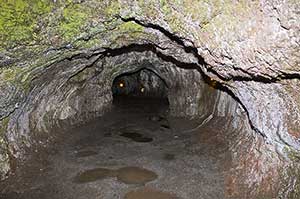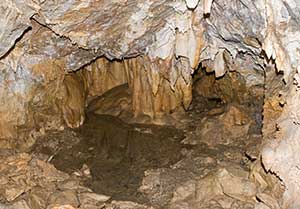| Uses of Caves | Exploring Caves | References | Timpanogos Cave | Lava Tubes |

|
| Thurston Lava Tube. |
Modified from:
W. E. Davies and I. M. Morgan
US Geological Survey
What is a Cave?
A cave is a natural opening in the ground extending beyond the zone of light and large enough to permit the entry of man. Occurring in a wide variety of rock types and caused by widely differing geological processes, caves range in size from single small rooms to interconnecting passages many miles long. The scientific study of caves is called speleology (from the Greek words spelaion for cave and logos for study). It is a composite science based on geology, hydrology, biology, and archaeology, and thus holds special interest for earth scientists of the U.S. Geological Survey.Caves have been natural attractions since prehistoric times. Prolific evidence of early man's interest has been discovered in caves scattered throughout the world. Fragments of skeletons of some of the earliest manlike creatures (Australopithecines) have been discovered in cave deposits in South Africa, and the first evidence of primitive Neanderthal Man was found in a cave in the Neander Valley of Germany. Cro-Magnon Man created his remarkable murals on the walls of caves in southern France and northern Spain where he took refuge more than 1O,000 years ago during the chill of the ice age.
Interest in caves has not dwindled. Although firm figures for cave visitors are not available, in 1974 about 1.5 million people toured Mammoth Cave in Kentucky, and more than 67O,000 visited Carlsbad Caverns in New Mexico, two of the most famous caves in the United States.

|
| Hanson lake within Timpanogos caves. This is classified as a solution cave. |
Types of Caves
A simple classification of caves includes four main types and several other relatively less important types.- Solution caves are formed in carbonate and sulfate rocks such as limestone, dolomite, marble, and gypsum by the action of slowly moving ground water that dissolves the rock to form tunnels, irregular passages, and even large caverns along joints and bedding planes. Most of the caves in the world-as well as the largest-are of this type.
- Lava caves are tunnels or tubes in lava formed when the outer surface of a lava flow cools and hardens while the molten lava within continues to flow and eventually drains out through the newly formed tube.
- Sea caves are formed by the constant action of waves which attacks the weaker portions of rocks lining the shores of oceans and large lakes. Such caves testify to the enormous pressures exerted by waves and to the corrosive power of wave-carried sand and gravel.
- Glacier caves are formed by melt water which excavates drainage tunnels through the ice. Of entirely different origin and not to be included in the category of glacier caves are so-called "ice caves," which usually are either solution caves or lava caves within which ice forms and persists through all or most of the year.
In desert areas, some shallow caves may be formed by the sandblasting effect of silt or fine sand being blown against a rock face. These eolian caves, some of which are spectacular in size, are surpassed in number by caves of other origins in most deserts. More common even in the driest deserts are sandstone caves eroded in part by water, particularly if the sandstone is limy. Caves commonly known as "wind caves," such as the one in Wind Cave National Park in South Dakota, are named not for the mode of origin of the cave but for the strong air currents that alternately blow in or out of the cave as the atmospheric pressure changes. Most wind caves are, in fact, solution caves.